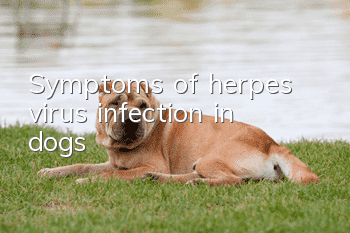Symptoms of herpes virus infection in dogs

Symptoms of herpes virus infection
The incubation period of the disease is 4-6 days, and puppies under 21 days old can cause fatal infection. In the early stage, sick dogs have dementia, are depressed, do not eat milk, have weak body, difficulty breathing, sensitive and painful abdomen during pressure test, and loose and yellow feces. The body temperature is not high, and the dog keeps howling, restless, and trembling. Some dogs show symptoms of rhinitis, including serous rhinorrhea, extensive spotty bleeding on the surface of the nasal mucosa, and the skin on the inner thigh can turn into red papules. In the later stages, sick dogs develop opisthotonus, epilepsy, and loss of consciousness. The vast majority of dogs die 24-48 hours after symptoms appear. Recovering dogs can cause permanent neurological symptoms, movement disorders, blindness, etc.
Dogs older than 21-30 days mainly show symptoms of upper respiratory tract infection, such as runny nose, cough, sneezing, dry cough, etc., which last for about 14 days and the symptoms are mild. Symptoms of pneumonia can occur when secondary mixed infections occur.
Adult female dogs mainly suffer from reproductive tract infection and diffuse vesicular lesions of the vaginal mucosa, which can lead to miscarriage, stillbirth and infertility in pregnant female dogs. Chronic inflammation of the penis and foreskin can be seen in male dogs, and a large amount of purulent secretions can be seen in the foreskin.
Treatment of Herpes Virus Infection
Newborn puppies infected with CHV have acute onset and high mortality. Focal bleeding in solid organs, especially the kidneys, has diagnostic significance and is of acute During the infection period, CHV can be isolated from various parenchymal organs such as adrenal glands, kidneys, lungs, spleen and liver. In convalescent or elderly dogs, CHV usually only exists in the oral mucosa, upper respiratory tract and external genital tract, making it difficult to isolate successfully. .CHV can proliferate well on primary canine kidney cells. The optimal culture temperature is 35 to 37°C. The infected cells become round and fall off, and the plaques are obvious. The smaller the plaques, the weaker the virulence. The identification of newly isolated viruses can be carried out by electron microscopy. Observation, immunofluorescence test or neutralization test are performed. Serum neutralization test can be used as a means of retrospective diagnosis and epidemiological investigation.
The treatment of acute systemic infection in newborn puppies is ineffective. Intraperitoneal injection of 1 to 2 ML hyperimmune serum into puppies during epidemic periods can reduce deaths. Increasing the ambient temperature is beneficial to sick dogs. Broad-spectrum antibiotics can be used for sick dogs with upper respiratory tract symptoms. Prevent secondary infection.
Key points for diagnosis of herpes virus infection
(1) Epidemiological characteristics of canine herpes virus infection, mainly fatal infection within 2 weeks of age, and fatal infection within 3 weeks Symptoms in adult dogs over 10 years old are mild and are mainly non-obvious infections.
(2)Clinical characteristics: When puppies under 2 weeks old are infected with this disease, their body temperature often does not rise, they are mentally retarded, have poor appetite or stop nursing. Difficulty breathing, abdominal pain, vomiting, and yellow-green stool. Sick dogs often howl continuously and often die within 24 hours after clinical symptoms appear. Some puppies that have tolerated it often have neurological symptoms such as ataxia, circular movements to one side, and blindness. After infection in puppies and adult dogs aged 3 to 5 weeks, they often do not show systemic symptoms and only cause mild rhinitis and pharyngitis, mainly showing runny nose, sneezing and sore throat.Upper respiratory tract symptoms such as sneezing and dry cough. Experiments have shown that the virus can multiply slightly on the respiratory and reproductive tract mucous membranes of these sick dogs and become a source of infection.
(3) Characteristics of pathological autopsy: Typical lesions in puppies are scattered gray-white necrosis lesions and small bleeding points with a diameter of about 2 to 3 mm in the parenchymal organs, especially the kidneys and lungs. The changes are more obvious. Bloody serous fluid accumulates in the chest and abdomen, the spleen is enlarged, and the intestinal mucosa has punctate bleeding.
Usually, a preliminary diagnosis can be made based on the above clinical characteristics and pathological changes, combined with popular characteristics. Final diagnosis depends on viral isolation or serology.
- How to raise a dog to be particularly loyal? Dog training tips!
- How to solve the problem of dogs causing destruction at home? The method is very important!
- Common Dog Diseases and Prevention
- How often should dogs be dewormed?
- How to tell if a dog is blind
- Why does a dog urinate blood? Poop shovelers should pay attention...
- What is the best medicine for Shiba Inu Kennel Cough?
- What can’t Bedlington Terriers eat?
- What is the most effective way for dogs to eat to gain weight?
- The dog's food-protecting behavior has a lot to do with its owner. How can it be improved?



